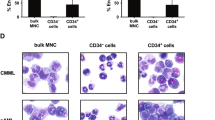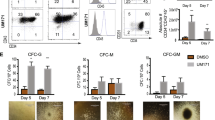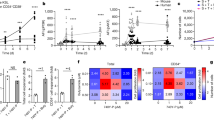Abstract
Bcr/abl fusion gene, in experimental models, induces survival to growth factor deprivation and hypersensitivity to IL3. However, conflicting data were reported about chronic myeloid leukemia (CML) progenitors. We investigated the responsiveness of purified CML CFU-GM to GM-CSF/IL3 and their survival to growth factor deprivation. CFU-GM hypersensitivity to IL3 and/or GM-CSF was found in 3/11 CML cases only. CML CFU-GM survived well in stroma-free ‘mass’ culture (5 × 104 cells/ml) without cytokine addition, up to day 11, average recovery being around 95% in medium + 10% fetal bovine serum and 67–81% in serum-free medium. Conversely, normal progenitors declined steadily, particularly after extensive purification (18 ± 10% recovery at the 7th day), and in serum-free medium (4 ± 6% recovery). By contrast, normal and CML CFU-GM declined in a similar way in limiting dilution cultures (1–10 cells/50 μl). We also investigated the effects of retinoic acid and α-interferon on CFU-GM survival. Both all-trans- and 13-cis retinoic acid, particularly in combination with α-interferon, reduced CML CFU-GM recovery down to normal progenitors’ values. In conclusion, hypersensitivity to CSFs is rare in CML, whereas resistance to growth factor deprivation has been confirmed in mass, but not in limiting, dilution cultures. Both stereoisomers of retinoic acid, at therapeutic concentrations and in combination with α-interferon, can overcome the survival advantage of CML progenitors.
This is a preview of subscription content, access via your institution
Access options
Subscribe to this journal
Receive 12 print issues and online access
$259.00 per year
only $21.58 per issue
Buy this article
- Purchase on Springer Link
- Instant access to full article PDF
Prices may be subject to local taxes which are calculated during checkout



Similar content being viewed by others
References
Nowell PC, Hungerford DA . A minute chromosome in human chronic granulocytic leukemia Science 1960 132: 1497–1501
Rowley JD . A new consistent chromosomal abnormality in chronic myelogenous leukemia identified by quinacrine fluorescence and Giemsa staining Nature 1973 243: 290–293
Ben-Neriah Y, Daley GQ, Mes-Masson AM, Witte ON, Baltimore D . The chronic myelogenous leukemia-specific P210 protein is the product of the bcr/abl hybrid gene Science 1986 233: 212–214
Shtivelman E, Lifshitz B, Gale PR, Canaani E . Fused transcript of abl and bcr genes in chronic myelogenous leukemia Nature 1985 315: 550–554
Puil L, Liu J, Gish G, Mbamalu G, Bowtell D, Pelicci PG, Arlinghaus R, Pawson T . BCR-ABL oncoproteins bind directly to activators of Ras signalling pathway EMBO J 1994 13: 764–773
Sattler M, Salgia R, Okuda T, Uemura N, Durstin MA, Pisick E, Xu G, Li JL, Prasad KV, Griffin JD . The protoncogene product p120 CBL and the adaptor proteins CRKL and C-CRK link c-ABL, p190BCR-ABL and p210 BCR-ABL to phosphatidylinositol-3′ kinase pathway Oncogene 1996 12: 839–846
Afar DE, Goga A, McLaughlin J, Witte ON, Sawyers C . Differential complementation of BCR-ABL point mutation with c-MYC Science 1994 264: 424–426
Yuan ZM, Huang Y, Whang Y, Sawyers C, Weichselbaum R, Kharbanda S, Kufe D . Role of c-ABL tyrosine kinase in growth arrest response to DNA damage Nature 1996 382: 272–274
Salgia R, Li JL, Ewaniuk DS, Pear W, Pisick E, Burky SA, Ernst T, Sattler M, Chen LB, Griffin JD . BCR/ABL induces multiple abnormalities of cytoskeletal function J Clin Invest 1997 100: 46–57
Daley GQ, Van Etten RA, Baltimore D . Induction of chronic myeloid leukemia in mice by the p210 BCR/ABL gene of the Philadelphia chromosome Science 1990 247: 824–830
Daley GQ, Baltimore D . Trasformation of an interleukin 3-dependent hematopoietic cell line by the chronic myelogenous leukemia-specific P210 bcr/abl protein Proc Natl Acad Sci USA 1988 85: 9312–9315
Hariharan IK, Adams JM, Cory S . bcr-abl oncogene renders myeloid cell line factor independent: potential autocrine mechanisms in chronic myeloid leukemia Oncogene Res 1988 3: 387–399
Laneuville P, Heisterkamp N, Groffen J . Expression of the chronic myelogenous leukemia-associated P210 bcr/abl oncoprotein in a murine IL-3 dependent myeloid cell line Oncogene 1991 6: 275–282
Bedi A, Zehnbauer BA, Barber JP, Sharkis SJ, Jones RJ . Inhibition of apoptosis by BCR-ABL in chronic myeloid leukemia Blood 1994 83: 2038–2044
Carlesso N, Griffin JD, Druker B . Use of a temperature-sensitive mutant to define the biological effects of p210 BCR/ABL tyrosine kinase on proliferation of a factor dependent murine myeloid cell line Oncogene 1994 9: 149–156
Sirard C, Laneuville P, Dick JE . Expression of bcr-abl abrogates factor-dependent growth of human hematopoietic M07E cells by an autocrine mechanism Blood 1994 83: 1575–1585
Cortez D, Kadlec L, Pendergast AM . Structural and signaling requirements for BCR-ABL-mediated transformation and inhibition of apoptosis Mol Cell Biol 1995 15: 5531–5541
Matsuguchi T, Inhorn RC, Carlesso N, Xu G, Druker B, Griffin JD . Tyrosine phosphorylation of p95Vav in myeloid cells is regulated by GM-CSF, IL-3 and Steel factor and is constitutively increased by p210 BCR/ABL EMBO J 1995 14: 257–265
Carlesso N, Frank DA, Griffin JD . Tyrosyl phosphorylation and DNA binding activity of signal transducers and activators of transcription (STAT) proteins in hematopoietic cell lines transformed by BCR/ABL J Exp Med 1996 183: 811–820
Zhang X, Ren R . Bcr-Abl efficiently induces a myeloproliferative disease and production of excess interleukin-3 and granulocyte–macrophage colony-stimulating factor in mice: a novel model for chronic myelogenous leukemia Blood 1998 92: 3829–3840
Aglietta M, Piacibello W, Gavosto F . Insensitivity of chronic myeloid leukemia cells to inhibition of growth by prostaglandin E1 Cancer Res 1980 40: 2507–2511
Cashman JD, Eaves CJ, Sarris AH, Eaves AC . MCP-1, not MIP-1alpha, is the endogenous chemokine that cooperates with TGF-beta to inhibit the cycling of primitive normal but not leukemic (CML) progenitors in long-term human marrow cultures Blood 1998 92: 2338–2344
Bhatia R, McCarthy JB, Verfaillie CM . Interferon-alpha restores normal beta 1 integrin-mediated inhibition of hematopoietic progenitor proliferation by the marrow microenvironment in chronic myelogenous leukemia Blood 1996 87: 3883–3891
Klein H, Becher R, Lubbert M, Oster W, Schleiermacher E, Brach MA, Souza L, Lindemann A, Mertelsmann RH, Herrmann F . Synthesis of granulocyte colony-stimulating factor and its requirement for terminal divisions in chronic myelogenous leukemia J Exp Med 1990 171: 1785–1790
Janowska-Wieczorek A, Belch AR, Jacobs A, Bowen D, Padua RA, Paietta E, Stanley ER . Increased circulating colony-stimulating factor-1 in patients with preleukemia, leukemia and lymphoid malignancies Blood 1991 77: 1796–1803
Jiang X, Lopez A, Holyoake T, Eaves A, Eaves C . Autocrine production and action of IL-3 and granulocyte colony-stimulating factor in chronic myeloid leukemia Proc Natl Acad Sci USA 1999 96: 12804–12809
Maguer-Satta V, Burl S, Liu L, Damen J, Chahine H, Krystal G, Eaves A, Eaves C . BCR-ABL accelerates C2-ceramide-induced apoptosis Oncogene 1998 16: 237–248
Amos TAS, Lewis JL, Grand FH, Gooding RP, Goldman JM, Gordon MY . Apoptosis in chronic myeloid leukemia: normal response by progenitor cells to growth factor deprivation, X-irradiation and glucocorticoids Br J Haematol 1995 91: 387–393
Albrecht T, Schwab R, Henkes M, Peschel C, Huber C, Aulitzky WE . Primary proliferating immature myeloid cells from CML patients are not resistant to induction of apoptosis by DNA damage and growth factor withdrawal Br J Haematol 1996 95: 501–507
Emanuel PD, Bates LJ, Castleberry RP, Gualtieri RJ, Zuckerman KS . Selective hypersensitivity to granulocyte-macrophage colony-stimulating factor by juvenile chronic myeloid leukemia hematopoietic progenitors Blood 1991 77: 925–929
Tarella C, Ferrero D, Caracciolo D, Badoni R, Bellone G, Gallo E . Immunological separation of two CFU-GM subsets showing different responsiveness to T-cell derived growth factors J Clin Lab Immunol 1988 25: 185–190
Ferrero D, Carlesso N, Gallo E, Pregno P, De Fabritiis P, Petti MC, Mandelli F . CD9 antigen on acute non-lymphoid leukemia: preferential expression by promyelocytic (M3) subtype Leuk Res 1991 15: 457–461
Tarella C, Boccadoro M, Omedè P, Bondesan P, Caracciolo D, Frieri R, Bregni M, Siena S, Gianni AM, Pileri A . Role of chemotherapy and GM-CSF on hemopoietic progenitor cell mobilisation in multiple myeloma Bone Marrow Transplant 1993 11: 271–277
Neu S, Geiselhart A, Sproll M, Hahn D, Kuci S, Niethammer D, Handgretinger R . Expression of CD44 isoforms by highly enriched CD34-positive cells in cord blood, bone marrow and leukaphereses Bone Marrow Transplant 1997 20: 593–598
Platzer E, Welte K, Gabrilove JL, Lu L, Harris P, Mertelsmann R, Moore MA . Biological activities of a human pluripotent hemopoietic colony-stimulating factor on normal and leukemic cells J Exp Med 1985 162: 1788–1801
Mochizuki DY, Eisenman JA, Conlon PJ, Larsen AD, Tushinski RJ . Interleukin 1α regulates hematopoietic activity, a role previously ascribed to hemopoietin 1 Proc Natl Acad Sci USA 1987 84: 5267–5271
Taswell C . Limiting dilution assay for the determination of immunocompetent cell frequency J Immunol 1981 126: 1614–1619
Shih LY, Chiu WF, Dunn P, Liaw SJ . In vitro culture studies of blood and marrow cells in chronic myeloid leukemia at different phases of the disease Blut 1988 57: 125–130
Eaves AC, Cashman JD, Gaboury LA, Kalousek DK, Eaves CJ . Unregulated proliferation of primitive chronic myeloid leukemia progenitors in the presence of normal marrow adherent cells Proc Natl Acad Sci USA 1986 83: 5306–5310
Moore S, Haylock DN, Levesque JP, McDiarmid LA, Samels LM, To LB, Simmons PJ, Hughes TP . Stem cell factor as a single agent induces selective proliferation of the Philadelphia chromosome positive fraction of chronic myeloid leukemia CD34(+) cells Blood 1998 92: 2461–2470
Coulombel L, Kalousek DK, Eaves CJ, Gupta CM, Eaves AC . Long-term marrow culture reveals chromosomally normal hematopoietic progenitor cells in patients with Philadelphia chromosome-positive chronic myelogenous leukemia N Engl J Med 1983 308: 1493–1498
Petzer AL, Eaves CJ, Barnett MJ, Eaves AC . Selective expansion of primitive normal hematopoietic cells in cytokine-supplemented cultures from patients with chronic myeloid leukemia Blood 1997 90: 64–69
De Fabritiis P, Dowding C, Bungey J, Chase A, Angus G, Szydlo R, Goldman JM . Phenotypic characterization of normal and CML CD34-positive cells: only the most primitive CML progenitors include Ph-neg cells Leuk Lymphoma 1993 11: 51–61
Misawa M, Maeda H, Hara H, Yamamoto Y, Furuyama J . Absence of bcr/abl gene in single hemopoietic progenitors in some patients with chronic myelogenous leukemia Stem Cells 1993 11: 536–542
Waller CF, Ali M, Heinzinger M, Lange W . Growth inhibition of Ph+ progenitor cells from CML patients using the tyrosine kinase inhibitor CGP57148B Anticancer Res 2000 20: 809–814
Druker BJ, Tamura S, Buchdunger E, Ohno S, Segal GM, Fanning S, Zimmermann J, Lydon NB . Effects of a selective inhibitor of the Abl tyrosine kinase on the growth of Bcr-Abl positive cells Nat Med 1996 2: 561–566
Aglietta M, Piacibello W, Stacchini A, Sanavio F, Gavosto F . In vitro effect of retinoic acid on normal and chronic myeloid leukemia granulopoiesis Leukemia Res 1985 9: 879–883
Zheng A, Savolainen ER, Koistinen P . All-trans retinoic acid combined with interferon-alpha effectively inhibits granulocyte-macrophage colony formation in chronic myeloid leukemia Leukemia Res 1996 20: 243–248
Sagayadan, GE, Wiernik PH, Sun N, Ahearn G, Thompson D, Hallam SJ, Hu XP, Dutcher JP, Gallagher RE . Effect of retinoic acid and interferon alpha on granulocyte–macrophage colony-forming cells in chronic myeloid leukemia: increased inhibition by all-trans and 13-cis-retinoic acid in advanced stage disease Leukemia Res 1994 18: 741–748
Mahon FX, Chahine H, Barbot C, Pigeonnier V, Jazwiec B, Reiffers J, Ripoche J . All-trans retinoic acid potentiates the inhibitory effects of interferon α on chronic myeloid leukemia progenitors in vitro Leukemia 1997 11: 667–673
Purton LE, Bernstein ID, Collins SJ . All-trans retinoic acid delays the differentiation of primitive hematopoietic precursors (lin−c-kit+Sca-1(+)) while enhancing the terminal maturation of committed granulocyte/monocyte progenitors Blood 1999 94: 483–495
Ferrero D, Carlesso N, Pregno P, Gallo E, Pileri A . Self-renewal inhibition of acute myeloid leukemia clonogenic cells by biological inducers of differentiation Leukemia 1992 6: 100–106
Ferrero D, Carlesso N, Bresso P, Roux V, Pregno P, Gallo E, Pileri A . Suppression of in vitro maintenance of non-promyelocytic myeloid leukemia clonogenic cells by all-trans retinoic acid: modulating effects of dihydroxylated vitamin D3, α interferon and ‘stem cell factor’ Leukemia Res 1997 21: 51–58
Cortes J, Kantarjian H, O’ Brien S, Beran M, Estey E, Keating M, Talpaz M . A pilot study of all-trans retinoic acid in patients with Philadelphia chromosome-positive chronic myelogenous leukemia Leukemia 1997 11: 929–932
Russo D, Regazzi M, Sacchi S, Visani G, Lazzarino M, Avvisati G, Pelicci PG, Dastoli G, Grandi C, Iacona I, Candoni A, Grattoni R, Galieni P, Rupoli S, Liberati AM, Maiolo AT . All-trans retinoic acid (ATRA) in patients with chronic myeloid leukemia in the chronic phase Leukemia 1998 12: 449–454
Handa H, Hegde UP, Kotelnikov VM, Mundle SD, Dong LM, Burke P, Rose S, Hsu WT, Gaskin F, Raza A, Preisler HD . The effects of 13-cis retinoic acid and interferon alpha in chronic myelogenous leukemia cells in vivo in patients Leukemia Res 1997 21: 1087–1096
Khan AA, Villablanca JG, Reynolds CP, Avramis VI . Pharmacokinetic studies of 13-cis-retinoic acid in pediatric patients with neuroblastoma following bone marrow transplantation Cancer Chemother Pharmacol 1996 39: 34–41
Acknowledgements
This study was supported by grants from ‘Ministero della Pubblica Istruzione’ (MPI 40%) and from ‘Associazione Italiana per la Ricerca sul Cancro’ (AIRC), Italy.
Author information
Authors and Affiliations
Rights and permissions
About this article
Cite this article
Ferrero, D., Foli, C., Giaretta, F. et al. Growth advantage of chronic myeloid leukemia CFU-GM in vitro : survival to growth factor deprivation, possibly related to autocrine stimulation, is a more common feature than hypersensitivity to GM-CSF/IL3 and is efficiently counteracted by retinoids ± α-interferon . Leukemia 15, 422–429 (2001). https://doi.org/10.1038/sj.leu.2402038
Received:
Accepted:
Issue Date:
DOI: https://doi.org/10.1038/sj.leu.2402038
Keywords
This article is cited by
-
Prometaphase arrest-dependent phosphorylation of Bcl-2 and Bim reduces the association of Bcl-2 with Bak or Bim, provoking Bak activation and mitochondrial apoptosis in nocodazole-treated Jurkat T cells
Apoptosis (2014)
-
Increased expression of fibroblast growth factor receptor 3 in CD34+ BCR-ABL+ cells from patients with chronic myeloid leukemia
Leukemia (2003)
-
Orchestration of multiple arrays of signal cross-talk and combinatorial interactions for maturation and cell death: another vision of t(15;17) preleukemic blast and APL-cell maturation
Oncogene (2001)



